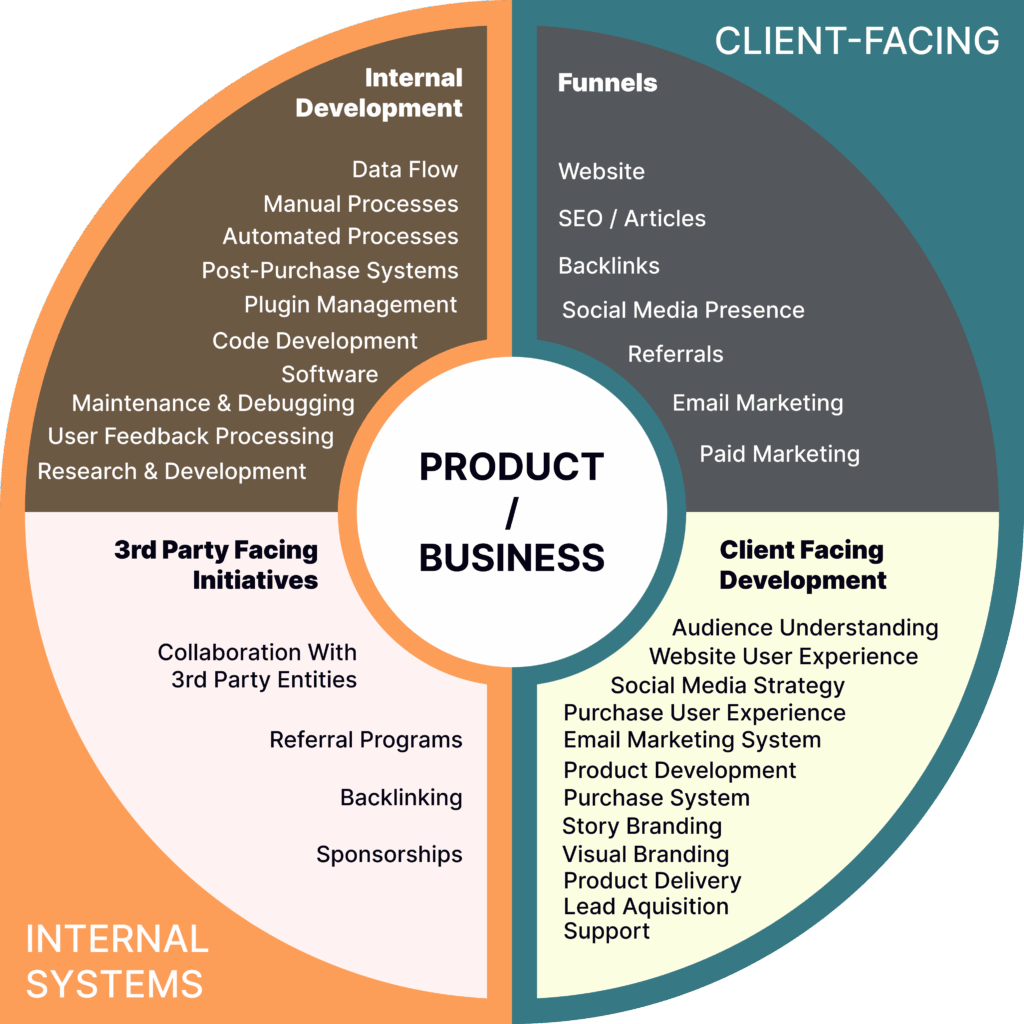It starts with a feeling.
You’re doing all the things: launching campaigns, refining your offer, improving your product. But despite your effort, something still feels… off. Growth is happening, but it’s heavy. Teams are misaligned. Tools overlap. Customers slip through cracks.
Most business advice doesn’t help because it’s fragmented.
“Fix your sales funnel. Tighten your messaging. Add automations. Fire up more content.”
It focuses on isolated tasks, without considering how they work together as a whole. And so we keep solving in silos: marketing here, operations there, tech somewhere else, hoping the puzzle will solve itself.
The Systems Thinker confirms what many business owners suspect: conventional wisdom shows that 70% or more of business change efforts fail to meet their objectives precisely because they focus on a single dimension of business. Whether it’s fixing the sales funnel or improving operations, these isolated efforts often make things worse by creating misalignment elsewhere.
Understanding a business means looking beyond individual problems and recognizing the dynamic systems at play.
Research backs up this system’s approach brilliantly. Harvard Business Review highlights that W. Edwards Deming, the father of continuous quality improvement, found that 94% of workplace issues are actually systemic, not individual problems. This means when your business feels “off,” it’s probably not because someone’s dropping the ball. It’s because the system itself needs attention.
“Nothing exists in a vacuum. Everything is interrelated.”
When you start looking at your business as an integrated whole, everything changes. You see how each piece influences the others: how a weak onboarding flow undercuts strong lead gen, or how internal chaos prevents your brand promise from being fulfilled.
You notice that fixing a tech issue without considering your team’s workflow only creates friction somewhere else. That launching a new campaign without syncing with operations leads to customer service chaos.
Seeing the business as a living system
So, how do you make sense of it all?
Start by shifting your view. Instead of thinking in terms of departments, think in terms of flow.
Everything your audience sees (your website, your content, your user experience) depends on things they don’t see: the tools you use, the handoffs between team members, the processes happening behind the curtain.
If the connections are weak, even the best tool won’t save you.
Holistic thinking means mapping these relationships. Understanding that every customer-facing action is supported by internal capabilities, and that every internal system either reinforces or undermines your external promise.
Instead of optimising one piece at a time, you begin to optimise the relationships between them. That’s where the leverage is.
And that’s where your business becomes more than the sum of its parts.
What does holistic alignment actually look like?
It looks like a business where front and back are fully synced.
Where the marketing campaign your audience sees reflects the delivery experience they actually get. Where your sales process flows smoothly because it’s supported by operations and informed by data.
In practical terms:
- Your brand message is consistent across your site, your content, your emails, and your team interactions.
- Well-designed funnels do more than convert; they guide leads smoothly into a sales process that’s ready to follow through.
- Operations aren’t overwhelmed because what’s promised up front is built on what the team can deliver behind the scenes.
- Data flows between systems, so the insights you act on reflect what’s actually happening.
“Growth happens when the systems work together, not in isolation.”
Alignment is less about creating the perfect plan and more about fostering coherence across everything your business does.
This comprehensive approach isn’t just good theory, but proven practice. Research on organisational change shows that true alignment must encompass three elements: goal (what we want), role (what we contribute), and soul (the meaning it has for us). It’s not enough to align your systems and processes; you need alignment that extends from your market strategy right down to individual team members. A shared rhythm that keeps the front and behind the business moving in sync.
That’s when friction fades. That’s when momentum builds.
What’s in front and behind the business
In front: What your audience sees
Every business has a public face. And a private engine room.

In the diagram we often use at Serenichron, there are two layers around the core of a business. The top layer, what sits in front of the business, is everything your audience sees and experiences:
- Your brand presence
- Funnels and marketing content
- Your website and social media
- The purchase journey and product delivery
These are your client-facing developments. They create the impression, expectation, and reputation of your business.
“Your audience only sees the front. But what sustains you is what’s behind.”
Behind: What holds it all up
Behind the scenes, what’s underneath the business, are the systems and operations that actually make it run:
- Internal development
- Automation and processes
- Feedback loops, technical infrastructure, and maintenance
- Team coordination, software, and code
This is your internal backbone. It doesn’t get applause, but it determines how well the visible parts actually perform.
Both sides matter. But here’s the trap:
If your front is polished and your back end is weak, you’ll impress people, but fail to deliver. If your back end is strong but your front is disjointed, you’ll be invisible.
Competing on alignment
And if you ignore both, your competitors won’t.
“If you don’t figure out your flow, the competition will.”
Customers today compare not just your product, but the total experience, from first impression to final delivery. They don’t care if your tools don’t talk to each other or if your internal systems are overloaded.
They just want it to work.
So ask yourself: Is the front of your business in sync with what’s behind it?
When these layers are aligned, when your audience-facing efforts are backed by real operational capacity, your business doesn’t just grow. It thrives sustainably.
Spotting misalignment in your business
Now that you’ve seen the relationship between the front and back of your business, it’s easier to recognise when things aren’t lining up.
Misalignment isn’t always dramatic. Sometimes it’s subtle, like small delays, confusion, or inconsistent experiences. But over time, those symptoms add up.
Here are some common signals:
- Your website and content say one thing, but your delivery tells another story
- Your sales team isn’t getting the right leads, or has to spend too much time qualifying them
- Behind-the-business processes require constant manual workarounds
- Support tickets pile up after a new campaign goes live
- Leaders work hard, but still feel like they’re constantly playing catch-up
“Most businesses grow in parts. The smartest ones grow in sync.”
The more of these symptoms you notice, the clearer it becomes: the challenges often lie in the way systems are structured and interact, not necessarily in individual performance. And it can be fixed by bringing the front and back of your business into alignment.
How to start thinking holistically
Holistic thinking begins with looking at the full picture, how everything connects and where alignment can unlock better results.
You don’t need a five-year plan or a complete rebuild. You just need to understand how your front-facing and behind-the-business elements interact.
Here’s how to get started:
- Map what your audience sees. Look at your website, marketing, and onboarding experience. What promises are you making?
- Trace those promises backward. Identify what internal tools, systems, and teams support that experience. Are they equipped and aligned?
- Find the breaks. Look for where things fall apart, slow handoffs, redundant work, and unclear ownership.
- Fix the flow, not just the function. Instead of just patching a tool or department, fix the connection between them.
- Get outside insight. Sometimes you’re too close to the system to see the misfires. That’s why many businesses bring in Serenichron, to help see and redesign the whole picture.
“You don’t need more hustle. You need better harmony.”
Holistic growth focuses on building clarity across your systems so that complexity doesn’t spiral into confusion. When your front-end experience and back-end engine align, everything moves smoother, and faster.
A real example: alignment in action
We recently worked with a certification business that was thriving publicly, but privately was struggling to keep up.
Their audience loves the brand. Their overall audience, accounting for social channels, email and website search engine visitors, numbered in the hundreds of thousands..
But behind the scenes, the manual processes associated with identifying the student, validating their exam scores and issuing their certificate were stretching the team to the limit – the employee carrying out the certifications had not been able to take a vacation in over a year, and if he ever got sick or something came up, the business owner had to be pulled in to cover the process directly.
The business looked polished in front, but behind the scenes it was buckling under pressure.
So we zoomed out.
Alongside the business owner, over many hours of calls, we pinpointed every single step, every click, every operation across every tool in their process:
- The certificate request forms
- The score checks
- The exam scores
- The customer’s history
- The spreadsheets, emails, naming schemes, storage folders and other minutiae…
Rather than focusing solely on fixing individual processes, we focused on restoring flow and coherence across the system:
- We picked out an appropriate tool that worked with the existing tool stack of the business, to make integration easy and avoid significant changes to processes
- We picked out every wasted click, every window switch, every action that did not require a decision to be made
- We set up all the logic to run automatically în the back-end…
And then we automated it all.
Whereas before, the business struggled to certify ~100 students per day, by stretching everyone’s work schedules…
After, the single employee could comfortably process 700 and have time to look at other improvements.The bottleneck that prevented the business from processing more 100
“Alignment didn’t just improve performance but it created the space for sustainable momentum.”
Sometimes what looks like a performance issue is really a flow issue. When the front and behind of the business connect smoothly, the team can finally move forward with clarity, energy, and less resistance.
So, what can you do right now?
Start by stepping back.
Don’t just look at your funnel or your tech stack or your next campaign. Look at the whole system, what’s visible to your customers, and what’s working behind the scenes.
Ask yourself:
- Is the experience we promote externally actually supported internally?
- Are my team and systems ready to deliver on the brand promise?
- Do our processes help the customer journey—or add friction?
“Successful businesses pay attention to both what the audience sees and the systems that support it behind the scenes.”
One simple exercise: print out a version of your business system. Mark the areas in front (marketing, brand, sales) and those behind (operations, tech, data).
Then trace a full customer journey, from ad click to product delivery. Where does the flow break down? Where does energy get lost?
You don’t need to have everything figured out right away. Taking the time to explore the full picture is the first meaningful step.
When to bring in a holistic consultant
Sometimes you can spot the flow problems, but you’re too deep in the day-to-day to untangle them. That’s okay. Business isn’t something you have to figure out alone.
If you’re feeling overwhelmed, scattered, or stuck in an endless loop of fixes that don’t last, this is when a holistic consultant can help.
Not to take over. Not to hand you a pre-made template.
But to walk alongside you. To help you zoom out, connect the dots, and rebuild a flow that fits your business.
A great holistic consultant helps you identify patterns, connections, and opportunities across your business, supporting the way each part contributes to the whole, from the brand your audience sees to the infrastructure that makes it real.
Whether it’s for a strategy reset or a long-term collaboration, bringing in fresh eyes could be the simplest way to restore clarity.
“Working with a consultant doesn’t mean giving up control. It means gaining another set of eyes, someone who can help you see the patterns, ask better questions, and find opportunities you may have missed.”
The goal isn’t to replace your vision, but to help sharpen it. With the right support, you can move forward more confidently and more cohesively.
Final thought: business isn’t linear
Designing a business involves building systems that can grow, adapt, and respond, more like an ecosystem than a fixed path.
A strong strategy brings together all the moving parts of your business into a flow that adapts, scales, and supports what your business stands for.
And if you’re ready to make that shift, you don’t have to do it alone.
Let’s redesign your business for flow, not friction.
About the Author

Alex writes about systems, strategy, and the underrated power of doing things the smart way, not just the fast way. As Serenichron’s system architect, he blends tech, operations, and business development into real-world solutions for entrepreneurs who want to scale with sanity.
About Serenichron

Helping businesses grow by simplifying strategy, streamlining systems, and making tech actually work for people. We bring clarity to chaos with practical tools, honest guidance, and just enough curiosity to question the default way of doing things.